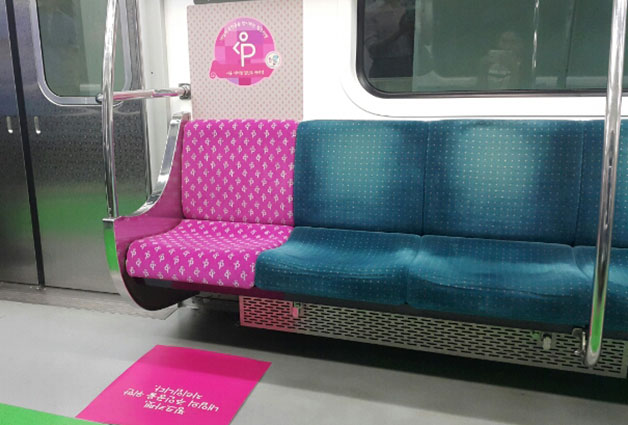If you’ve visited South Korea and taken the subway, you might have noticed something unusual—brightly colored seats with no one sitting in them, even during rush hour. This is especially true for seats covered in pink fabric or marked with specific signs.
What are these mysterious empty seats? Why are people avoiding them, even when the train is crowded?
Let’s uncover the story behind Korea’s “Pink Carpet” seats and the special seating system in Korean public transport.
What Is the “Pink Carpet” Seat?
The “Pink Carpet” seat refers to designated seats for pregnant women on Korean subways. They are marked by:
- Pink-colored seat cushions
- Floor decals resembling a pink carpet
- Signs or LED lights showing a pregnant woman icon
These seats are not just symbolic—they are part of a national effort to support expecting mothers and create a more considerate public space.
What About the Elderly Priority Seats?
In addition to the pregnancy seats, every Korean subway car also has a row of priority seats for the elderly (usually near each door). These are often labeled with signs and illustrations.
Rule of Thumb:
Even if the train is empty, you’re not supposed to sit there unless you belong to that group.
Many Koreans will stand in front of these seats rather than sit down, out of deep respect and cultural habit.
Why Were These Seats Created?
South Korea has:
- One of the lowest birth rates in the world
- A rapidly aging population
- A strong emphasis on filial piety and respect for elders
To encourage childbirth and show respect to seniors, these seats were introduced as a non-verbal but visible form of support.
It also helps reduce discomfort or awkwardness—pregnant women don’t have to ask for a seat, and seniors don’t feel the need to request one.
Why Do People Avoid Sitting There?
To foreigners, it might seem strange that no one is sitting in a visibly available seat. But in Korea, this is a social norm rooted in mutual respect.
- Peer pressure: People may judge you for sitting in a reserved seat, even if no one is around.
- What if someone gets on? Many prefer to avoid awkwardness by simply not sitting at all.
- Deep-seated respect: Cultural values prioritize others’ needs over your own convenience.
Some Koreans even describe sitting in a pregnancy or elderly seat as “social suicide” unless you have the proper reason.
🇰🇷 Cultural Insight: Harmony Over Individualism
Korea’s subway seating culture highlights a broader aspect of Korean society: the idea of collective harmony and consideration.
Whereas in many Western countries, “first come, first served” applies even to seats, in Korea, what’s polite matters more than what’s allowed.
Can Foreigners Sit in These Seats?
Technically, yes. But socially? It’s best to avoid it unless you’re eligible.
If you’re unaware and sit down, no one may say anything, but you might get disapproving looks.
Pro Tip: Always check for seat signage. If it’s pink, has an elderly symbol, or a visible decal—stand instead.
Final Thoughts
The empty seats on Korean subways are more than just transportation features—they are reflections of Korean values: respect, compassion, and quiet consideration.
So next time you see a seat no one’s using, ask yourself not “Can I sit there?” but rather “Who might need this more?”
✨ Did You Know?
- Some cities in Korea use motion sensors or LED indicators to show when a pregnant woman is nearby to keep seats available.
- There’s also a “mom badge” system, where pregnant women wear a pink pin that silently signals their condition.
